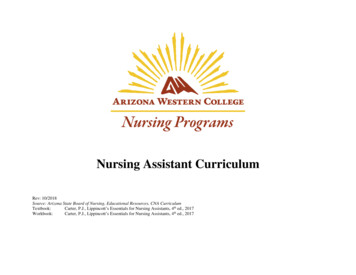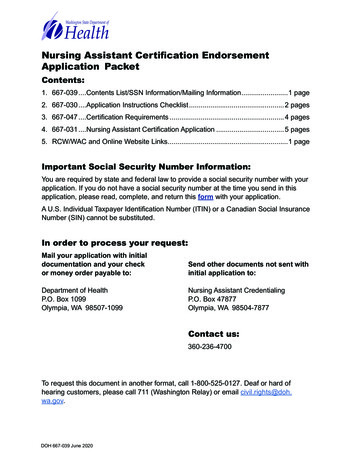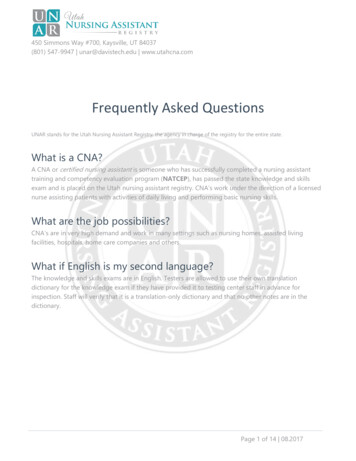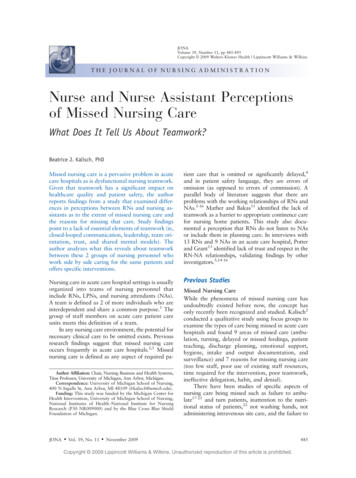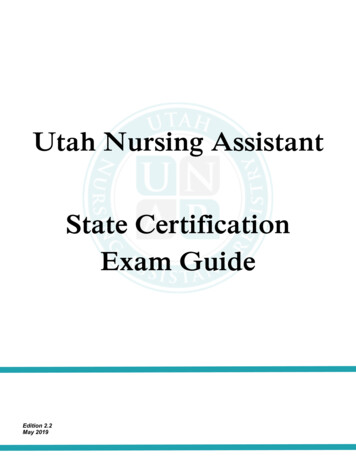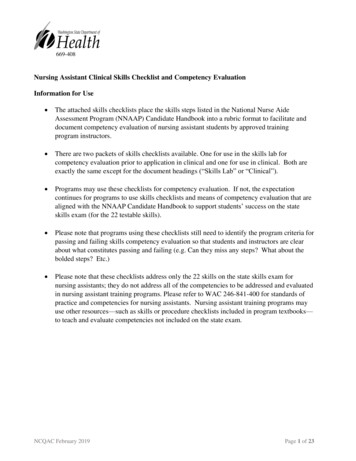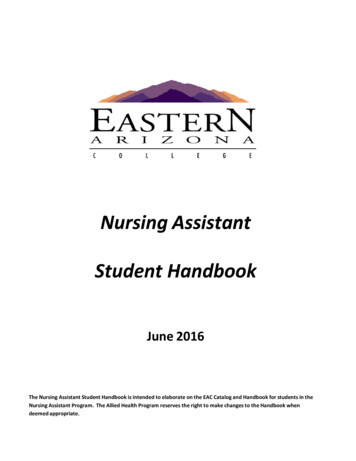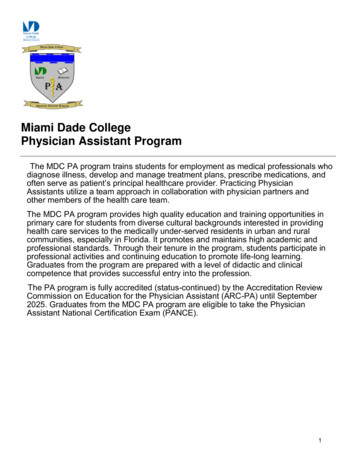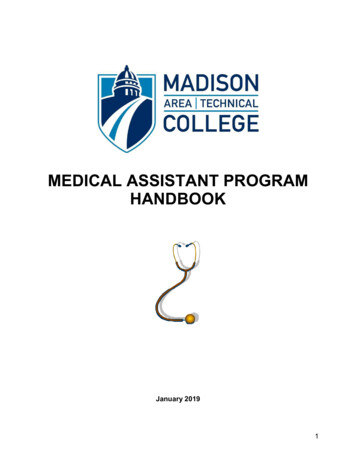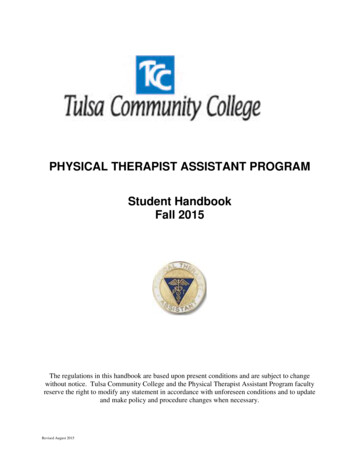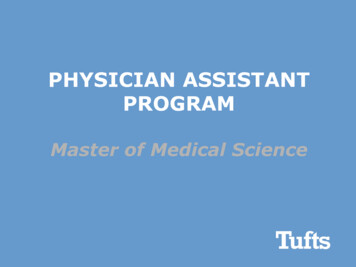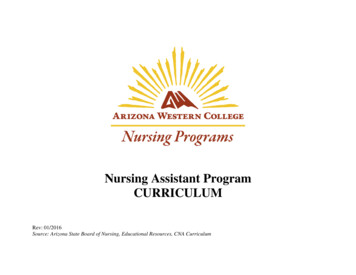
Transcription
Nursing Assistant ProgramCURRICULUMRev: 01/2016Source: Arizona State Board of Nursing, Educational Resources, CNA Curriculum
Textbook:Carter, P.J., Lippincott’s Textbook for Nursing Assistants, 4th ed., 2016Carter, P.J., Lippincott’s Workbook for Nursing Assistants, 4th ed., 2016Learning Activities and/orReading Assignment Resources1.0 Competency: Functions as a member of the health team within the health care facility and/or community./ Time Allotted for Competency: 6 hrs.1.1 Identifies essential functions of theFunctions, similarities, difference in the following:Read:health care facility and states the differencesA. Acute carebetween acute, long-term, assisted living,B. Long-term care Chapter 1: The Health Carehome care and hospice.C. Assisted LivingSystemD. Home care Chapter 2: The NursingE. RehabilitationAssistantF. Hospice. Chapter 3: Professionalism &1.2 Explains the essential duties of theFunctions and duties of nursing personnel:Job-seeking Skillsnursing team within a care facility.A. RN Chapter 4: Legal & EthicalA. Identifies the essential function of the RN. B. LPNIssuesB. Identifies the essential function of theC. Nurse Assistant Chapter 7: Overview of LongLPN.D. Organization structureTerm CareC. Identifies the essential function of theE. Working with other members of the team e.g., Arizona State Board ofnurse assistant.physician, dietician, Dietary Technician, PhysicalNursing, Nurse Practice Act D. Discuss the elements of a functioningTherapist, Nurse Practitioner, speech therapist and SocialRules: Article 8. Certifiedteam.WorkerNursing AssistantsE. Works with other members of the teame.g., physician, dietician, Dietary Technician,Assignment:Physical Therapist, Nurse Practitioner, speech Complete related Workbooktherapist and Social Workerchapters.Learning Goals1.3 Explains the nursing assistant role asoutlined in the different regulatory andprofessional guidelines.1.4Describes the delegation process.Content OutlineRegulatory agencies and professional guidelines.A. Omnibus Budget Reconciliation Act (OBRA)B. Arizona State Board of Nursing prescribedrequirements for certificationC. Arizona State Board of Nursing prescribedrequirements for recertificationD. Standards of conduct (R4-19-814)E. Ethics in the workplaceF. Informed consentG. Advanced Directives/ do not resuscitateDelegation process:A. Responsibility and accountability in delegationB. Factors affecting delegationC. 5 Rights of delegationD. Accepting and refusing delegation
Learning Goals1.5 Demonstrates professional work habitsand time management skills.Content OutlineLearning Activities and/orReading Assignment ResourcesGuiding principles:A. Time management skillsB. Application in the work settingC. Realistic resident care assignment load1.6 Demonstrates appropriate stressGuiding principles:relieving techniques.A. Stress management techniquesB. Application in the work setting2.0 Competency: Demonstrates ethical and legal behavior that maintains resident’s rights./ Time Allotted for Competency: 2 hrs.2.1 Demonstrates ethical and legal behaviorRegulatory agencies and professional guidelinesRead:by maintaining the standards set forth for theA. Concepts of ethical and legal behavior for healthcarehealth care professions.professional (emphasis on nursing assistant standards) Chapter 2: The NursingA. Explains the functions, rolesB. Functions, roles, limits and state certification processAssistantresponsibilities and legal limits of nursingunder the Arizona State Board of Nursing Standards of Chapter 4: Legal & Ethicalassistant/practice.Conduct for Nursing Assistants; Federal laws regulatingIssuesB. Discuss the regulatory boards, state andstandards of care/conduct (Omnibus Budget Reconciliation Chapter 16: The Patient orfederal statutes, rules and regulations,Act – OBRA); Joint Commission on Accreditation ofResident Environmentstandards and legal and advisory opinions that Healthcare Organizations (JCAHO) standards and(Objective 2.7)affect the practice of the nursing assistant.Occupational Safety and Health Administration standards Chapter 18: BedmakingC. Explains state certification and renewal(OSHA) Chapter 13: Patient Safety &requirements for CNAs – include criminalC. Nursing Assistant CertificationRestraint Alternativesconduct.1. AZBN Basic Educational Requirements(Objective 2.10)D. Identifies the standards of conduct that2. Process for initial certification Chapter 1: The Health Carethe nurse assistant must maintain in their daily3. Felony Bar – criminal conductSystem (Objective 2.11)care of residents.4. Certification renewal requirements Chapter 7: Overview of LongE. Demonstrates professional behaviors.D. Standards of conductTerm CareF.Accurately utilizes vocabulary1. Federal Chapter 29: Thewords/terms related to ethical/legal behavior2. Arizona Standards of Conduct for NursingMusculoskeletal Systemand resident rights.Assistants(Objective 2.12)3. JCAHO standards4. OSHA standardsAssignment:E. Characteristics of professional behavior (examples such Complete related Workbookas):chapters.1. Caring2. Competent3. Conscientious (including personal hygiene)4. Courteous5. Dependable/Timely6. Honest
Learning GoalsContent Outline7. Team playerF. Key Terms1. Abandonment2. Abusea. Physical abuseb. Sexual abusec. Verbal abused. Emotional abuse Threats Humiliatione. Involuntary seclusionf. Financial abuse3. Advance Directive4. Advocate5. Assault6. Battery7. Code of conduct8. Defamation of charactera. Slanderb. Libel9. Dual relationship & professional boundaries10. Ethics11. False imprisonment12. Informed consent13. Invasion of privacy14. Neglecta. physical neglectb. psychosocial neglect15. Ombudsman16. Privacya. Personalb. Visitsc. Telephone conversationsd. Information about care17. Quality of Life18. Restraintsa. Chemical restraintsb. Physical restraintsLearning Activities and/orReading Assignment Resources
Learning Goals2.2 Interprets, explains and applies theResident’s Bill of Rights.2.3 Provides for resident privacy.A. Describes the resident’s right to privacy.B. Explains how the nursing assistant canhelp the resident maintain the right to privacy.2.4 Maintains resident confidentiality.A. Describes the resident’s right toconfidentiality.B. Identifies how the nursing assistant canprotect the resident’s right to confidentiality.Content Outline19. Self-Determination Act20. Standards of Care21. TheftPrinciples and rationale of Resident’s Rights (Right to )A. Free choiceB. Freedom from abuse and restraintsC. PrivacyD. Confidentiality of personal and clinical records(Health Insurance Portability and Accountability Act HIPPA standards)E. Accommodation of needs1. Physical2. PsychosocialF. Organize and participate in family & resident groupsG. Participate in social, religious and community activitiesH. Examine survey results and correction plansI. Manage personal fundsJ. Information about eligibility for Medicare/MedicaidbenefitsK. File complaints about abuse, neglect ormisappropriation of propertyL. Information about advocacy groupsM. Immediate & unlimited access to family or relativesN. Share a room with partner/intimacyO. Perform or not perform work for the facilityP. Remain in the facilityQ. Use personal possessionsR. Notification of change in conditionPrinciples and rationale of right to privacy:A. Review methods to maintain privacy (i.e. not takingvital signs in public areas such as the dining room).B. Maintaining privacy while performing resident care.Principles and rationale of maintaining confidentiality:A. HIPPA regulations on confidentiality “unintendedreceiver”.B. Methods to protect the resident’s right toconfidentiality.Learning Activities and/orReading Assignment Resources
Learning GoalsContent Outline2.5 Promotes the resident’s right to makepersonal choices to accommodate their needs.A. Describes the resident’s right to personalchoice.B. Offers choices when caring for residents.Principles and rationale of promoting resident’s personalchoices:A. Guidelines, examples situations describing the right tochoose.B. Methods to protect the resident’s rights to makepersonal choices.Guidelines in resolving grievances.A. Key terms and concepts:1. Grievance2. Ombudsman3. Resident’s CouncilB. Methods to resolve grievances and disputes within thenursing assistant role.Security of residents’ personal possessions.A. Principles and rationale of safeguarding residents’personal possessions.B. Methods to care and secure residents’ possessions.1. Safe for valuables2. Labeling personal items and containers.2.6 Gives assistance in resolving grievancesand disputes.A. Describes the resident’s right to voicedisputes and grievances.B. Explains the role of the nursing assistantwhen residents voice concerns, complaints orquestions about treatment or care.2.7 Maintains care and security ofresident’s personal possessions.A.Describes the resident’s right related tothe care and security of personal possessions.B.Explains the role of the nursing assistantin safeguarding resident’s personalpossessions.2.8 Promotes the resident’s right to be freefrom abuse, mistreatment and neglect.A.Explains the role of the nursing assistantin protecting the resident from abuse,mistreatment and neglect.B.Describes types of elderly abuse.C.Identifies signs of abuse.2.9 Reports any instance of abuse,mistreatment or neglect to the appropriatesupervisor.A.Discuss the legal requirement andconsequences for failure to report abuse,mistreatment or neglect.B.Reviews appropriate methods and chainof command to report instances of abuse,mistreatment or neglect.2.10 Utilizes interventions that minimize theneed for restraints.Principles and rationale of protecting resident from abuse,mistreatment and neglect:A. Signs of abuse, mistreatment and neglect.B. Methods to protect the resident from abuse,mistreatment and neglect.C. Signs of resident abuse.Principles and rationale to report abuse, mistreatment orneglect:A. OBRA and state requirements1. Employee responsibility2. Consequences for failure to report.B. Methods to report abuse, mistreatment or neglect:1. Chain of Command2. Facility policy3. Community agenciesPrinciples and rationale for the appropriate use of restraints.A. Ethical and legal issues of using restraints.Learning Activities and/orReading Assignment Resources
Learning GoalsContent OutlineA.Identifies ethical and legal issues in theuse of restraints.B.Describes the resident’s right to be freeof restraints.C.Identifies the role of the nursingassistant in helping to keep the resident freefrom restraint.D.Provides for resident’s basic needs andre-applies restraints as appropriate.E.Observes and reports resident’s statuswhile in protective devices.1. JCAHO guidelines2. Physician orders3. Release restraints every 2 hours and document4. Methods to avoid using restraintsB. Right to be free from restraint1. Informed consent2. Least restrictive form3. Types of restraintsa. Physicalb. Chemicalc. Active restraintd. Passive restraintC. Alternative to restraints.1. Diversion2. Company3. Activities4. Exercise5. Basic needs met6. OtherD. Care of resident in restraint1. observe according to protocols2. restraint removed, person repositioned, basic needsmet at least every 2 hoursE. Agency guidelines for checking resident anddocumentationGuidelines to support resident’s independence.A. Principles and rationale of promoting residentindependence.Learning Activities and/orReading Assignment Resources2.11 Promotes resident independence.A.Describes the resident’s right related toself-determination, self-care andindependence.B. Methods to promote resident’s independence.B.Identifies actions nursing assistantsmay take to promote resident independence.Guidelines to support resident’s involvement in activities.2.12 Assists residents to participate inA. Principles and rationale of assisting resident toactivities.participate in activities.A.Describes the resident’s right to1. Activities of Daily Livingparticipate in family and group activities.B. Provides for activities of daily living and 2. Family meetingsB. Methods to assist resident to participate in activities.restorative activities for clients.3.0 Competency: Assists in identifying the mental health and social service needs of residents./ Time Allotted for Competency: 4 hrs.
Learning GoalsContent Outline3.1 Discuss basic human needs of theindividual.A. Identifies basic human needs throughoutthe lifespan, including physical, socio-cultural,social service and mental health needs.B. Identifies the developmental tasksassociated with the aging processC. Describes mental status and behaviorchanges.D. Identifies the role of the elderly in thehome and community, including cultural andreligious aspects.Basic Human NeedsA. Maslow’s hierarchy and Erickson’s developmentstagesB. Basic human needs of the adult moving from middleadulthood through late adulthood.1. The young-old: 60-74 years2. The middle-old: 75-84 years3. The old-old: older than 85 yearsC. Mental and behavior changes1. Impact of restrictions such as reduced income onpsychosocial relationships.2. Changes due to disease process and agingD. Role of elderly in home and community.1. Cultural and religious outlooks about older adults.2. Changing family dynamics throughout aging.3. Housing options as aging progresses.4. Impact of retirement and increased time andavailability.Examples of cultural and spiritual preferences andresponses that may influence the approach to caring for theresident.A. Health care beliefs.B. Sick care practices.C. Family members’ roles.3.2 Explains how cultural and spiritualattitudes may influence psychologicalresponses.A. Identifies ways to accommodate culturaland spiritual differences.B. Identifies the nursing assistant’s role inrespecting cultural and spiritual differences.3.3 Identifies sources of stress common toresidents.A. Defines stress.B. Explains the difference between mentalhealth and mental illness.C. Identifies nursing assistant’sresponsibility of reporting signs andsymptoms of stress and/or inappropriatecoping mechanisms to supervisor.3.4 Provides appropriate care for residentswith mental health problems.Basic concepts of Mental Health.A. Definition of stress.B. Definition of mental health.C. Common causes of stress related to life stages.1. Signs and symptoms of stress2. Common coping mechanisms3. Potential for self-harmCare for residents with common mental health problems.A. AnxietyB. DepressionLearning Activities and/orReading Assignment ResourcesRead: Chapter 6: Those We CareFor (Objective 3.1)Chapter 8: The Long-TermCare ResidentChapter 40: Caring for PeopleWith Mental Illness(Objective 3.3, 3.4, 3.5)Chapter 6: Those We CareFor (objective 3.6, 3.7)Assignment: Complete related Workbookchapters.
Learning Goals3.5 Modifies own behavior in response toresident behavior.A. Identifies the nursing assistant’s role inmaintaining a respectful attitude for the personwho displays difficult behavior.B. Identifies at least three effectiveapproaches to managing difficult behavior ofresidents.Content OutlineLearning Activities and/orReading Assignment ResourcesC. Affective disordersD. SchizophreniaE. Substance abuseF. Eating disordersG. Potential for self-harmA. Nursing assistant role when interacting with residentsexhibiting difficult behavior.B. Effective approaches to managing difficult behaviors ofresidents.1. Distraction.2. Relaxation techniques3. Calm environment4. Adjusting time of care5. Encouraging family participationAppropriate and inappropriate expressions of sexuality.A. Common myths.B. Reporting responsibilities related to sexuality.3.6 Describes ways that residents may beexpressing their normal sexuality.A. Identifies common myths related tosexuality.B. Identifies nursing assistant’sresponsibility of reporting inappropriateexpressions of sexuality to supervisor.Various communication methods and enhancing two-way3.7 Facilitates the resident’s expression ofexchange of ideas and responding to needs.needs and provides supportiveA. Supporting choices and control in activities of dailycommunication.living.A. Assists and encourages residents to beB. Adaptation of personal care to accommodate residentindependent in the activities of daily living.preferences.B. Modifies care to accommodate residentC. Family participation in supporting the resident to strivevalues, customs, preferences or habits.towards common goals.C. Utilizes resident’s family as a source ofresident emotional and/or spiritual support.[4.0] Competency: Demonstrates effective communication. / Time Allotted for Entire Competency: 2 hrs.4.1 Uses verbal and nonverbalCommunication concepts:communication to accurately presentA. Medical terminology and abbreviations.information.B. Types of communicationA. Uses appropriate medical terminology and C. Chain of command.abbreviations.D. Communication techniquesB. Communicates with members of theE. Conflict managementhealthcare team.Read: Chapter 5: CommunicationSkillsAssignment:
Learning GoalsC. Communicates with residents and family.4.2 Responds effectively to resident’sbehavior in a positive non-threatening way.A. Identifies communication guidelines.B. Identifies barriers to communication.4.3 Observes and describes resident’sphysical and emotional condition changes.A. Identifies subjective observations.B. Identifies objective observations.C. Identifies emergencies.Content OutlinePrinciples of positive communication.A. Communication guidelines.B. Barriers to communication.Key concepts for recognizing changes to report.A. Subjective observations.B. Objective observations.C. When to report.1. Emergencies versus routine observations.2. Timeliness of reporting observations.Communication skills for residents with a sensory deficit.A. Guidelines for communicating with the hearingimpaired.B. Guidelines for communicating with the visuallyimpaired.C. Guidelines for communicating with the aphasicresident.D. Guidelines for communicating with the cognitivelyimpaired resident.E. Guidelines for communicating with the comatoseresident.F. Guidelines for communicating with the physicallyaggressive resident.G. Guidelines for communicating with the verballyaggressive resident.4.4 Demonstrates communication skills withthe resident who has sensory deficits.A. Demonstrates effective communicationwith hearing impaired resident.B. Demonstrates effective communicationwith the visually impaired resident.C. Demonstrates effective communicationwith the aphasic resident.D. Demonstrates effective communicationwith the cognitively impaired resident.E. Communicating with the comatoseresident.F. Demonstrates effective communicationwith the physically aggressive resident.G. Demonstrates effective communicationwith the verbally aggressive resident.5.0 Competency: Maintains a safe environment for the resident and others. / Time Allotted for Competency: 2 hrs.5.1 Identifies ways to promote safety andPrinciples of environmental safety.handle non-medical emergencies.A. Concepts to understandA. Explains safety and risk management1. Safetyprinciples and concepts.2. Risk managementB. Adheres to safety policies and plans of3. Accident/incident reportingthe facility.4. Safety hazardsC. Describes how to use safety equipment.B. Environmental safety plans, policies, procedures andtheir purposes.1. Safety/risk management2. Disaster plansLearning Activities and/orReading Assignment Resources Complete related Workbookchapters.Lab: Complete a resumeJob interview (Done last weekof class)Read: Chapter 12: Workplace SafetyChapter 14: Positioning,Lifting, & TransferringPatients/ResidentsChapter 38: Caring for PeopleWith Rehabilitation NeedsAssignment:
Learning Goals5.2 Identifies environmental safety hazardsand methods used to prevent accidents.A. Identifies environmental safety hazards.B. Identifies common measures andprinciples to prevent accidents.C. Identifies the common types of injuriesoccurring in health care facilities.D. Utilizes measures to identify risk fa
C. Explains state certification and renewal requirements for CNAs – include criminal conduct. D. Identifies the standards of conduct that the nurse assistant must maintain in their daily care of residents. E. Demonstrates professional behaviors. F. Accurately utilizes

